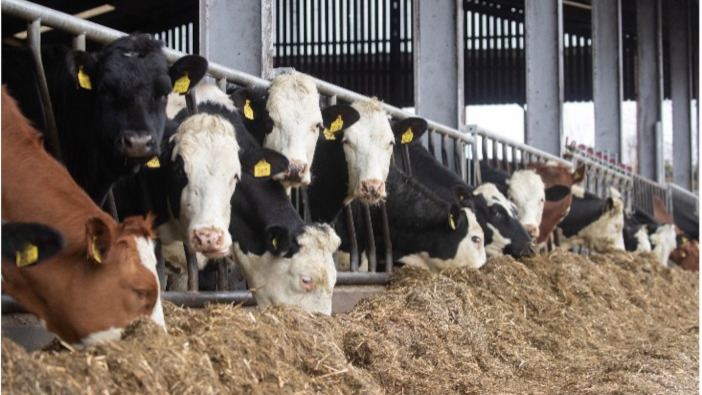A genetic index specifically developed for use with ProCROSS cattle has been revised to make this dairy crossbreeding programme easier and more effective.
The ProCROSS Ranking (PCR) is formulated to help those using this structured breeding programme – which alternates the VikingRed, VikingHolstein and Coopex Montbéliarde breeds – to improve the profitability of their herds through better genetic selection.
The formula of the PCR is built with two key considerations that differentiate it from pure breed indexes. One is its recognition of the relative differences between the breeds, allowing the crossbreeding producer to gain more of each breed’s strengths.
The other accounts for hybrid vigour, also known as heterosis, which is the uplift in performance that comes through breeding unrelated bloodlines. Heterosis greatly improves health and fertility traits, as well as lifespan.
Feed efficiency comes into focus
A positive of this crossbreeding index is the inclusion of DigeR, an innovative feed efficiency index that Coopex has developed for the Montbéliarde breed. The index results from research identifying milk’s fatty acid profile as a strong predictor of a cow’s ability to digest forage.
Feed efficiency is also included in the breeding goal for VikingGenetics’ breeds through the Saved Feed Index in the Nordic Total Merit Index (NTM), which is based on data from the Cattle Feed Intake System (CFIT). CFIT is an AI-based system that uses 3D cameras and deep learning to monitor each cow’s feed intake in commercial farms, 24/7, over their lifetime. Data from 4,000 VikingRed and 5,000 VikingHolstein cows are available.
Heterosis is the difference
In many other respects, the PCR is not unlike many national breeding indexes such as £PLI in the UK, ISU in France or NTM in the Nordic countries and its revision at this point follows the review of these native indexes.
National breeding indexes play an essential role in genetic selection; however, their focus is exclusively on pure breeds. “They are designed to identify superior individuals within pure breeds and under the assumption that zero heterosis exists among the cows being bred,” explained Amy Hazel Loeschke, a bovine geneticist specialised in ProCROSS.
“But this is not the case with ProCROSS, where all commercial cows have substantial hybrid vigour, and the average level of that heterosis differs from trait to trait,” she said. “So, the PCR considers how heterosis will affect the breeding outcome as well as the most critical traits farmers have found across the 24-year history of ProCROSS.”
The outcome is an index that places a greater emphasis on traits with moderate or high levels of heritability but low heterosis.
Emphasising higher production
The PCR has also increased its emphasis on production and udder conformation, both of which are moderately heritable but have low levels of heterosis. This allows for production to be weighted up to 50%, higher than in most pure breeding indexes (see Figure 1).
The emphasis on fat production has also been increased for the Montbéliarde to reflect the average global prices from markets where manufactured products are preferable.
“For each of the three breeds, the PCR emphasises traits that need the most within-breed improvement,” continued Dr Loeschke. “It also aims to improve body size uniformity between the three pure breeds.”
The PCR index benefits from the Holstein’s high production while moderating its stature. For VikingRed, it improves production and udder conformation and increases body size. Lastly, it enhances the Montbéliarde’s production and milking speed while moderating stature and improving temperament.
More refined results
Breeders using the PCR will achieve more uniformity, better udder conformation and higher production across their ProCROSS herds than if they used each breed’s separate purebred index.
According to Dr Loeschke, this will result in a lower culling rate, longer productive lifetimes, and improved feed efficiency thanks to DigeR and the Saved Feed Index. This combination will net ProCROSS farmers higher profits and better cows.
Dr Loeschke added that the index will continue to be refined as more data from more ProCROSS cows becomes available to be used alongside data from the three breeds.
“Today, the weightings on the traits are based on theoretical knowledge around crossbreeding and input from the experiences of dairy farmers,” she explained. “But in the future, performance data from ProCROSS cows should drive the emphasis on traits, and the index can continue to be improved by addressing needs of individual herds more precisely.”
More profitable cows
As with most genetic indexes, the PCR is centred around a unique base for each breed, so it cannot be used to compare bulls from one breed against another.
“This really doesn’t matter when you’re engaged in the ProCROSS programme as there is no need to compare bulls across the breeds. That’s because ProCROSS always uses each of the three breeds in sequential rotation,” she said. “However, there is a need to select the best bulls within a breed, and PCR is a tool that helps farmers achieve this.”
The University of Minnesota has conducted extensive long-term research, revealing that ProCROSS cows produce a higher daily profit of +9% than pure Holsteins. This is due to the combination of a longer lifespan, higher lifetime production of milk and solids, better fertility, fewer health treatments, higher calf and cull values, and lower death losses.
Using PCR as a foundation for ProCROSS breeding will mean farmers get a cross-section overview of economically important traits to focus on, leading to increased profitability.



